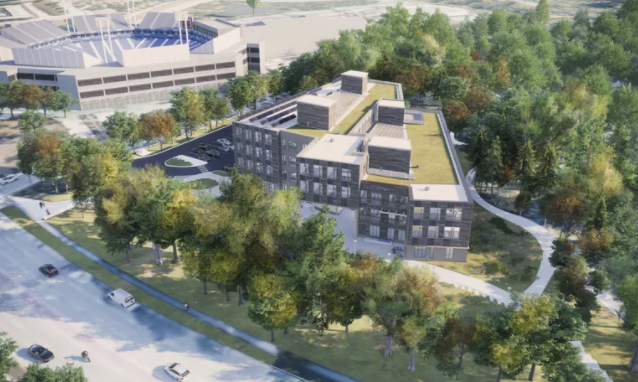Special feature
The Carpenters’ District Council Ontario (CDCO) is hosting an orientation breakfast on Mass Timber – and what it means for Ontario – on Nov. 24 at the Paramount Event Venue, 222 Rowntree Dairy Road, Woodbridge.
A discussion will be held during the breakfast from 8 to 10:30 p.m. with panelists Mark Gaglione from EllisDon; Leith Moore, R-Haliz; Brock O’Donnell, Rothoblaas; and David Moses, Moses Engineering.
Another highlight of the event will be a tour of Mass Timber Training at the College of Carpenters from 10:30 a.m. to noon.
As a result, huge opportunities are created for Ontario’s northern and Indigenous communities when it comes to resource development, cultivation, and sustainability. It also means more carbon capture as well as the benefits of the beauty of wood.
“The advent of Mass Timber couldn’t be happening at a better time for the world’s lungs, green targets, and Ontario’s economy”, says Mike Yorke, President of the Carpenters’ District Council.
New construction technology has created Cross-Laminated Timber (CLT) where smaller wood pieces are bound together to create large wooden beams that are as strong as steel, and just as fire resistant.
“In mass timber construction, the new technique gives wood similar strength properties to steel – and makes it just as fire retardant. Ontario’s oldest building resource – wood – is now our newest,” Yorke said.
Returning to the renewable, carbon-capture qualities of wood with new technology applications is what Mass Timber is all about. The oldest resource is now new again. Developing this industry also means jobs for many, including historic First Nations communities in our north.
The CLT market is forecast to reach $3.6 million USD by 2027, according to Market Research Future (MRFR). In 2020 the total was about $1.7 million.
Buttcon is building the first mixed-use residential, transit-oriented CLT mass timber project in Canada at Coxwell Avenue and Queen Street in Toronto.
“This is an incredibly exciting project,” says Yorke. “It’s mass timber meeting mass transit. It’s unique and innovative and it’s going to totally transform our inner cities.”
The entire super structure is expected to go up in six weeks, with no concrete above the foundation.
“I think once developers and builders realize how successful and how fast it can go up with little impact on the area, it’s going to take off,” said Tony Currie, program director, College of Carpenters and Applied Trades.
Another project, the new Toronto and Region Conservation Authority headquarters, tucked into the edge of a forested ravine is designed by ZAS Architects + Interiors with Bucholz McEvoy Architects
TRCA’s facility will be a cedar-clad mass timber structure that “provides a strong biophilic work environment and acts as a repeated visual reminder of the building’s connection to the natural environment,” according to ZAS.
The building’s exterior cedar cladding fits the historic 19th-century structures at an adjacent open-air heritage museum.
The four-story mass timber structure is set to be complete by September of this year with occupancy scheduled for September 2022.
“We envisioned TRCA’s new workplace as one that will inspire, motivate and support the culture of its employees, who are champions of the local environment. We approached the design as an opportunity to reimagine the TRCA’s relationship with Black Creek Ravine, of which TRCA is a guardian,” said ZAS principal Peter Duckworth Pilkington in a statement.
The 87,000-square-foot administrative office building aims to be one of the most energy-efficient commercial mid-rise buildings in North America, targeting Net Carbon Zero, LEED Platinum V4, Toronto Green Standard Level 2, and WELL Silver certifications).
The building’s features include Ontario-sourced exterior cedar cladding and the cost of the mass timber structure is $65 million.
Mass timber is a building trend that is expected to grow across Canada.
The 2021 State of Mass Timber in Canada (SMTC) report, the first of its kind to systematically document domestic mass timber construction projects and production capacity in Canada, provides a glimpse into market trends and demonstrates the value for builders and designers to consider building with wood.
The Green Construction through Wood (GCWood) program produced the report to record, review and analyze the rise of mass timber construction in Canada. This report highlights the progress Canada has made in mass timber production, design and building, as well as the potential for our country’s ongoing leadership in this area.
A key highlight of the SMTC report is an interactive map, which displays information on nearly 500 completed or under-construction mass timber projects from 2007 to 2019, representing over 1.5 million square metres (16 million square feet) of gross floor area. 21 mass timber manufacturing facilities across Canada, showing the growing capacity of domestic producers, are also displayed.
The rise of mass timber construction in Canada
The growth in mass timber construction across Canada can be linked to:
- progressive building codes
- new mass timber products
- innovative building systems
- a growing number of designers and builders with expertise
- increasingly affordable products and systems
- interest in green building materials and sustainable designs
To learn more about mass timber in Ontario, attend the CDCO breakfast. RSVP is required at Snicholson@thecarpentersunion.ca.

